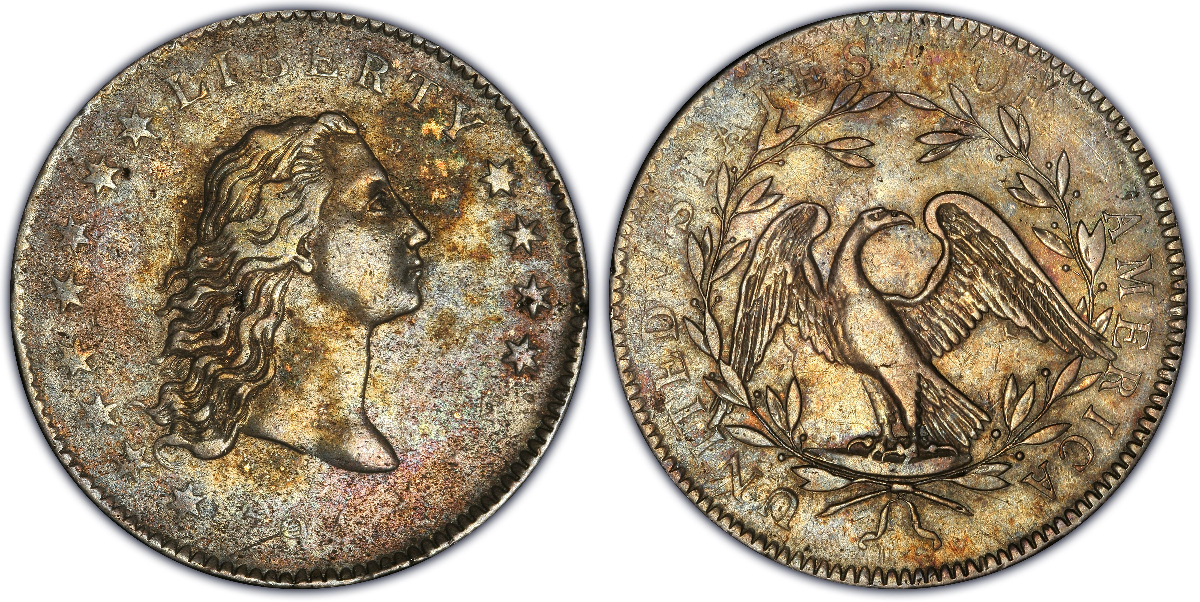
Coin Snapshot
- Weight: 26.96 grams
- Composition: 90% silver, 10% copper
- Diameter: Varies (39-40 mm)
- Thickness: Varies
- Years Minted: 1794-1795
- Designed by: Robert Scot
- Total Coins Struck: 162,053
Issued by the United States Government in 1794, the debut of the Flowing Hair Dollar marked a significant milestone in the history of the United States. As the first official silver dollar minted by the United States of America, it was modeled after the Spanish Dollar, which was a widely accepted form of payment at the time – both in the United States and throughout North America. Consequently, the Flowing Hair Dollar was struck in the same size, weight and metal composition as the Spanish Dollar, although the design was drastically different and totally unique to the United States of America.
Though it was only minted for two years (1794 and 1795), the Flowing Hair Dollar is an immensely significant piece of history for both coin collectors and historians. It was one of the first coins officially struck by the United States Mint after its creation via the passage of the Coinage Act of 1792. Less than 2,000 coins were minted during its first year in circulation, making it extremely scarce today. In total, less than 170,000 Flowing Hair Dollar Coins were struck overall between 1794 and 1795.
Out of the 1,758 coins struck during the first year of circulation (1794), less than 10 coins remain in original Mint State Condition as of 2023 (according to PCGS Survival Estimates: https://www.pcgs.com/coinfacts/coin/1794-1/6851).
Flowing Hair Dollar Coin Design
The Flowing Hair Dollar was designed by Robert Scot in 1794. As per the requirements set forth in the Coinage Act of 1792, the coins were required by law to contain an image of Lady Liberty as well as the national bird; an eagle. Before coins were released for circulation and during their initial production, the US Mint paid extra attention to the detail and quality of the coins, as it would be the biggest and most widely used coins within the newly formed nation. Because of this, it was believed that the coin was going to be judged and possibly criticized by foreign countries.
After the dies were designed and finished, the US Mint struck copper test pieces to take extra caution before releasing the coins to the public for circulation. At this point, US Mint officials decided to add fifteen stars around the diameter of the obverse side of the coin, representing the original fifteen states that first ratified the Constitution.
Though the design used for the bust of Lady Liberty as well as the Eagle and other imagery on the coins were done by Robert Scot, the mint brought Frederick Geiger to complete the lettering on the reverse side of the coin. Frederick was well-known, and had worked as a typographer throughout his career for several books, newspapers and other publications.
Obverse Design
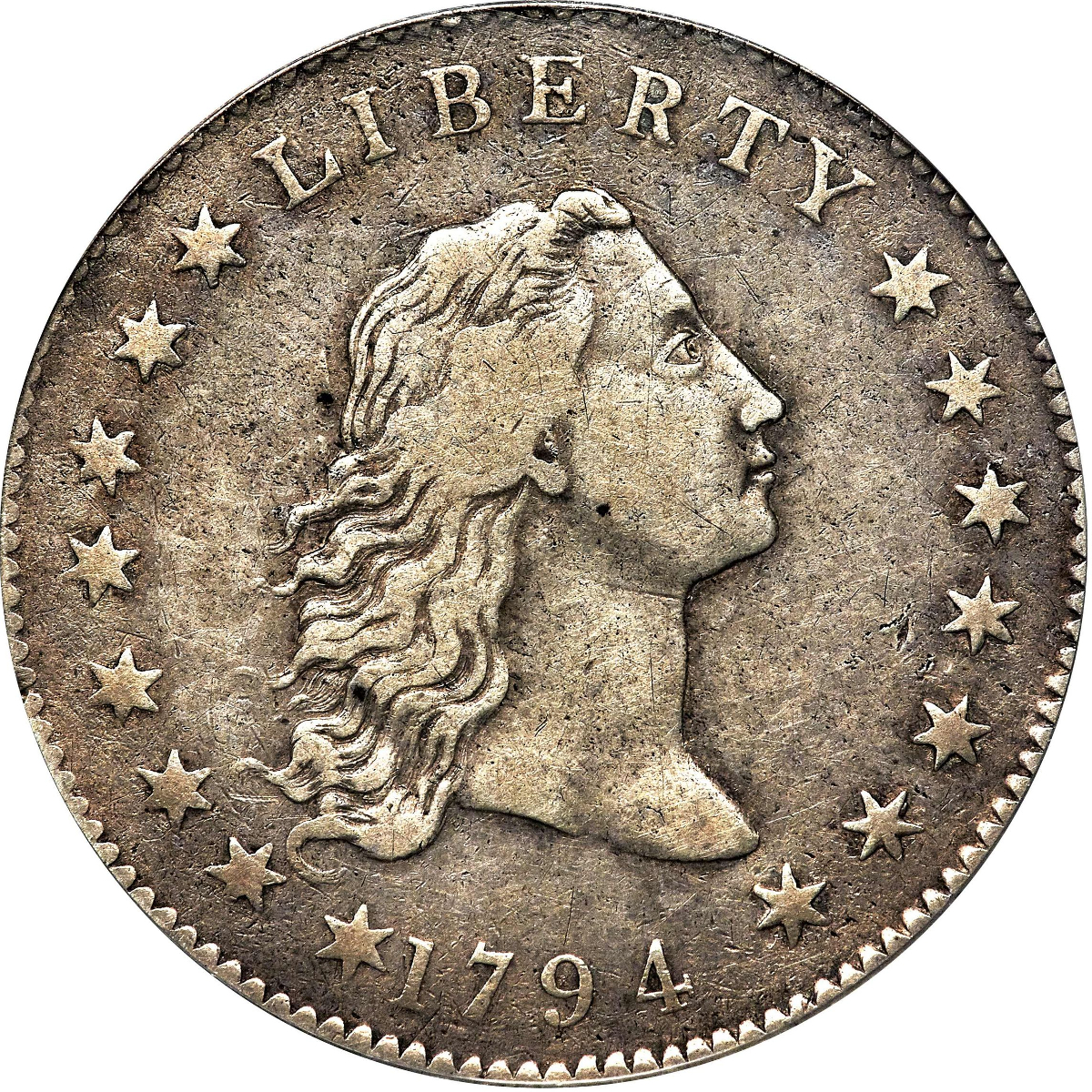
On the obverse side of the Flowing Hair Dollar coin is a bust of Lady Liberty designed entirely by Robert Scot. When looking at the coin, Liberty is facing the right, signifying the East and a new day. Above Liberty’s bust is the word “LIBERTY” in capital letters. Reeded edges can be observed around the entire perimeter of the coin. There are eight 6-point stars around the perimeter to the left of Lady Liberty. To her right are 7 stars adding up to a total of 15 stars on the obverse, which represent the first 15 states of the newly formed United States. Directly below Liberty’s neckline, at the center of the coin, the year is stamped.
Reverse Design
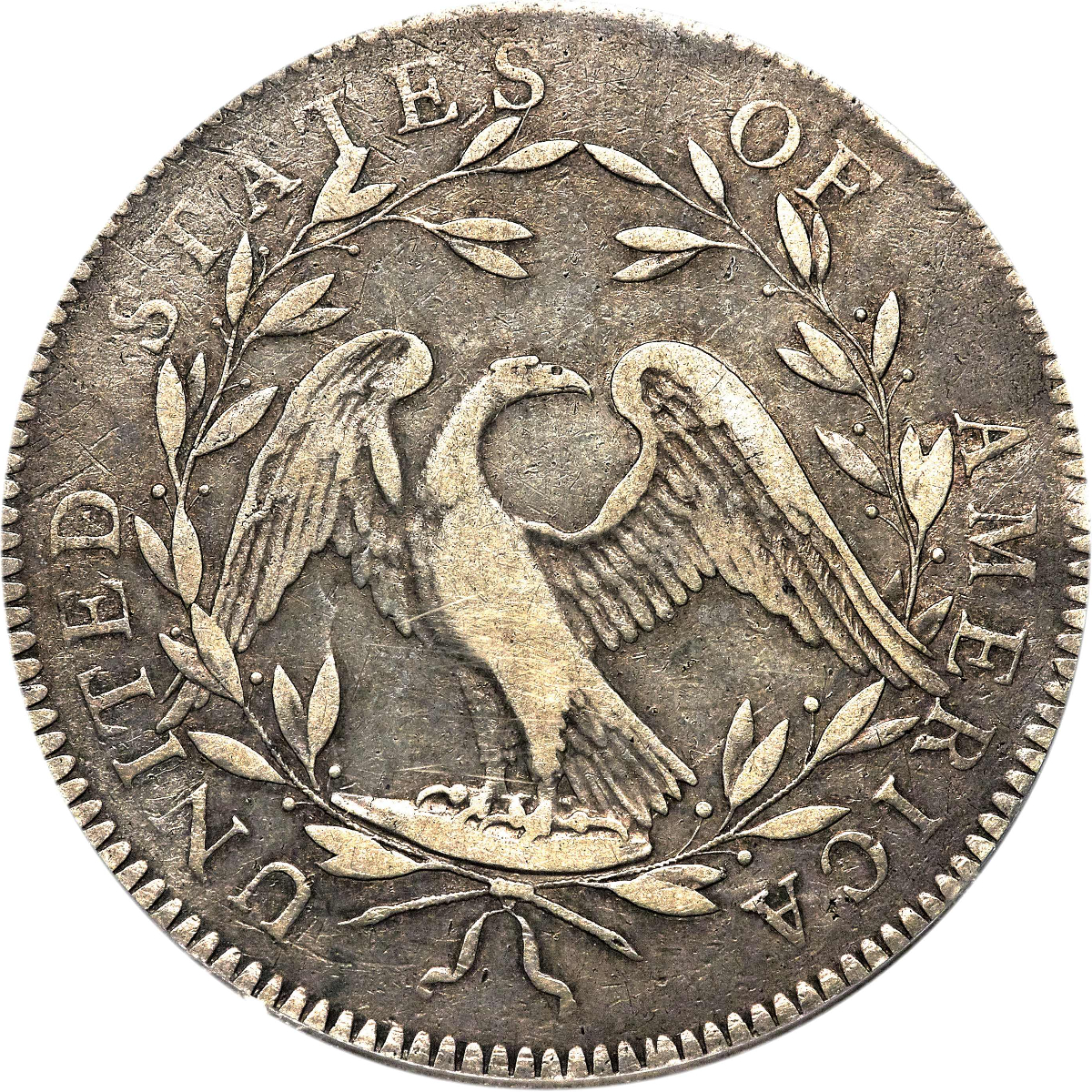
On the reverse side of the Flowing Hair Dollar, an Eagle is the focal point of the coin and is located at its center. Like Lady Liberty on the obverse, the eagle is also facing to the right. The eagle is perched atop a wreath, which bows out and surrounds him. The country’s name is stamped around the eagle in capital letters, reading “UNITED STATES OF AMERICA”.
Mint Locations and Mintmarks on the Flowing Hair Dollar
Since the Flowing Hair Dollar was one of the first US coins released after the creation of the United States Mint, each coin was struck exclusively at the Philadelphia Mint. This was the only national mint location during that time. Because of this, Flowing Hair Dollars do not contain any mintmarks. Virtually all US coins that have been minted in Philadelphia since the 1790s also do not contain a mintmark; even to this day (2024).
Flowing Hair Dollar Mintage Chart
| Year | Mintmark | Mint Location | Variety | Mintage |
|---|---|---|---|---|
| 1794 | (None) | Philadelphia, PA | All | 1,758 |
| 1795 | (None) | Philadelphia, PA | All | 160,295 |
History of the Flowing Hair Dollar
Before the Flowing Hair Dollar or any other federally-backed coinage could be minted and released into circulation by the United States, a national mint would first need to be established to strike the coins and distribute them throughout the country. The newly formed nation had many more important things to figure out during its infancy, and a mint was not atop the list. Beginning in the early 1780s, however, many Americans and politicians began to request that the United States begin to set up a centralized national mint to produce the nation’s coins and currency.
Establishing a National Mint
Some of the initial proposals to establish a national mint did not pass due to a lack of congressional funds, while others did not pass due to opposition; mainly related to the fact that some people felt the individual states should each be responsible for minting their own coinage. In 1789, the United States Constitution was ratified and came into force. This essentially granted Congress the power to coin money and regulate the value of that money as well as regulate the value of of foreign coinage. It also gave them the power to standardize the weight and monetary value of the coins.
Alexander Hamilton’s Study on the Monetary System
The following year (1790), Congress began meeting and deliberating about the United States’ monetary system, including the nation’s coinage. In 1790, Alexander Hamilton (Treasury Secretary) conducted a study on the monetary system and the potential of a United States Mint. In 1791 he presented the results from his study and discussed with Congress the potential of a United States Mint. Since the Spanish Dollar was the most widely used coins of the times, Hamilton had a series of assay tests performed on it. These coins are what the coinage within the United States monetary system would be based on a few years later.
The result of this report was that the first dollar (Flowing Hair Dollar) should contain 371.25 grains of silver with a gross weight of 416 grains. The remainder of the coin would contain copper, to provide the coins with more durability. On March 3, 1791, Congress passed a joint resolution authorizing a federal mint. This was the first step in establishing a national mint for the United States of America and as such it did not provide very much in the way of specifics or funding.
Production of the First Flowing Hair Dollars
In 1792, the United States began construction of the Philadelphia Mint. By early 1793, the building and its facilities were completed and fully operational. Initially, only United States Cents were produced here and were only minted in copper. A year later, in 1794, engraver Robert Scot began preparing designs for the nation’s first ever silver dollar. His design would be modeled after the United States Cent coin, which he also designed.
Flowing Hair Dollar Prices
Since the Flowing Hair Dollar was one of the first coins to be officially minted by the United States and such a limited number of coins were minted, they are extremely rare. Though they are generally very scarce, you can still find plenty of examples available for sale at any given time, though it is nothing compared to more widely available coins like the Morgan Silver Dollar.
These immensely valuable coins are sought out by both coin collectors and historians alike, adding to their demand. Combine this with the fact that less than 170,000 coins were struck overall, even a low quality coin (a coin in About Good (3) or Good (G, 4-6) condition) usually sell for at least a few thousand dollars. Higher quality examples will generally sell for tens-or hundreds of thousands of dollars!
Rare and Expensive Flowing Hair Dollars
As mentioned in the previous section, virtually every example of the Flowing Hair Dollar is rare and generally “expensive” (depending on what your budget is). In fact, one example of a Flowing Hair Dollar holds the record for most expensive coin ever sold at auction at over $10,000,000 USD!
The First Flowing Hair Dollar Ever Struck in 1794
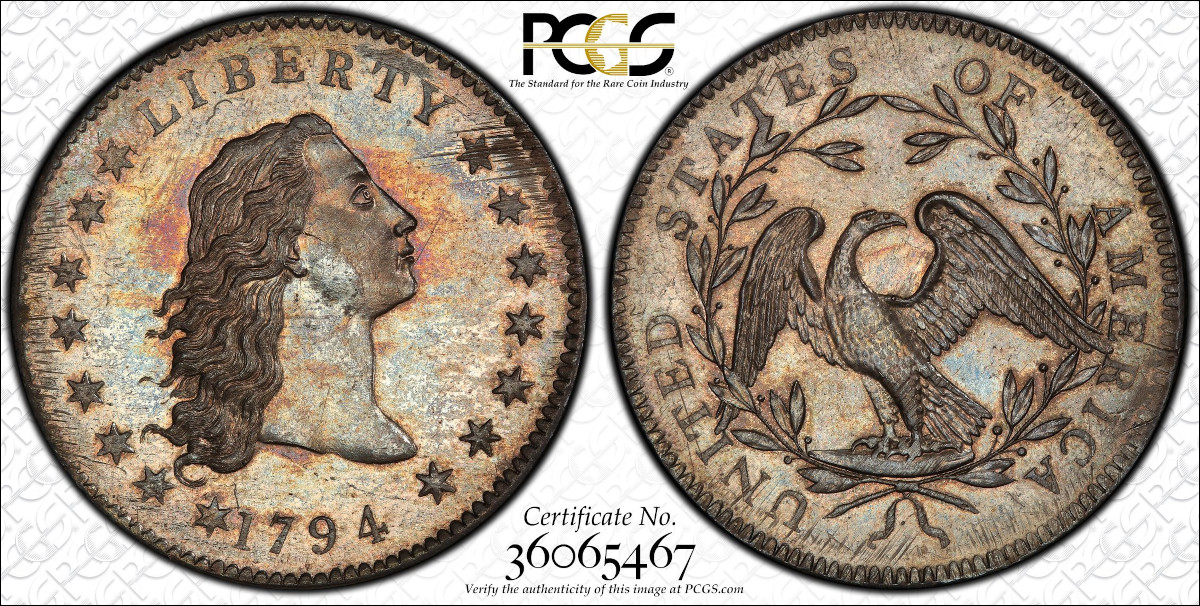
In 2013, a certified specimen 1794 Flowing Hair Dollar PCGS SP66 with a CAC sticker sold for $10,016,875 – making it the most expensive coin ever sold at the time. It was believed to be the first Flowing Hair Dollar struck by the United States Mint, and thus, the first silver dollar officially minted by the United States Government after the passage of the Coinage Act of 1792. The coin is (so far) the only known example of a Flowing Hair Dollar that contains a silver plug.
Other 1794 Flowing Hair Dollars
When it comes to the 1794 Flowing Hair Dollar, it is not uncommon to see a low quality example (in G6 condition) sell for $100,000. When you start to examine coins in F to XF and even AU condition, you will see some examples selling for $700,000 or more! This is because the 1794 issue is so scarce and there are not many examples left. On top of that, as the first US Silver Dollar ever minted by the United States, it is not only sought out by coin collectors, but also historians, investors and many other types of individuals.
1795 Flowing Hair Dollar
As for the 1795 issue, it is much more attainable for the average collector, as many more coins were struck that year. Even so, there are only a few thousand examples that are known to exist, according to PCGS and NGC certification numbers. A collector can acquire one of these coins in Good condition for right around $5,000, while a nicer example in XF or AU condition will run anywhere between $25,000 and $50,000.
Flowing Hair Dollar Condition and Certification
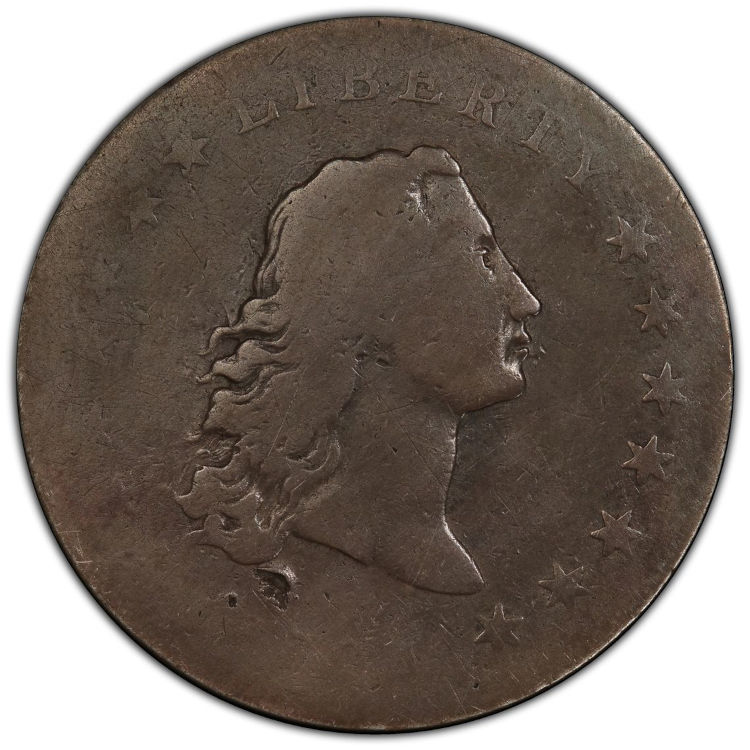 Minted over 200 years ago, in 1794 and 1795, Flowing Hair Dollars are usually very hard to find in Mint State (MS) or even Almost Uncirculated (AU) condition. On top of this, the coins were some of the first produced by the newly formed United States Mint, so the minting process was not yet optimized.
Minted over 200 years ago, in 1794 and 1795, Flowing Hair Dollars are usually very hard to find in Mint State (MS) or even Almost Uncirculated (AU) condition. On top of this, the coins were some of the first produced by the newly formed United States Mint, so the minting process was not yet optimized.
The coins were used as a form of trade within the United States, potentially for over 200 years, so many surviving examples will generally show a lot of wear on their surfaces. For this reason, it is most common to find them in Poor or Good condition.
When purchasing a Flowing Hair Dollar for your collection, you will likely want to acquire one that has been certified by NGC or PCGS, since part of their certification process involves authenticating the coin. Just like any other expensive or rare item, whether it be a coin, artwork, or something else, there are some “fakes”, replicas, and other lookalikes that need to be avoided.
